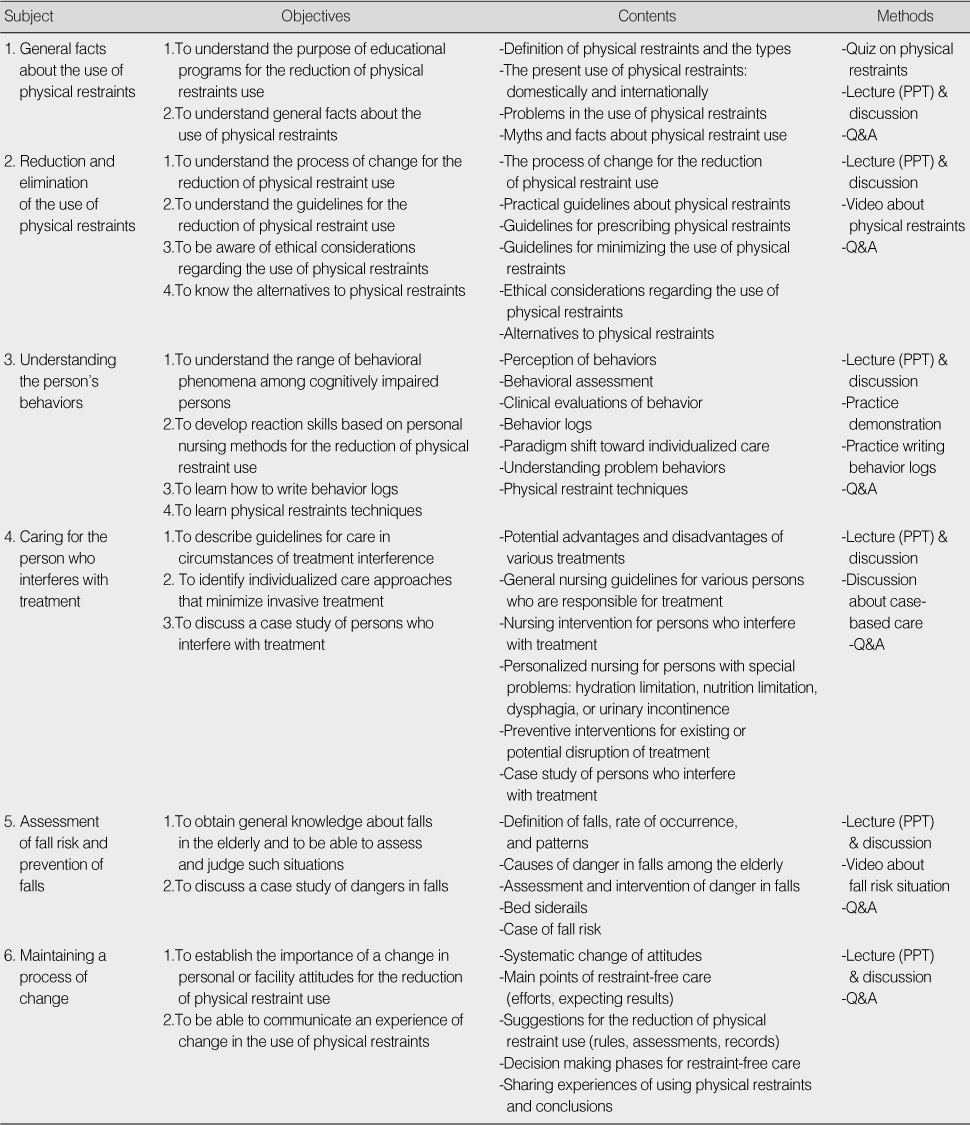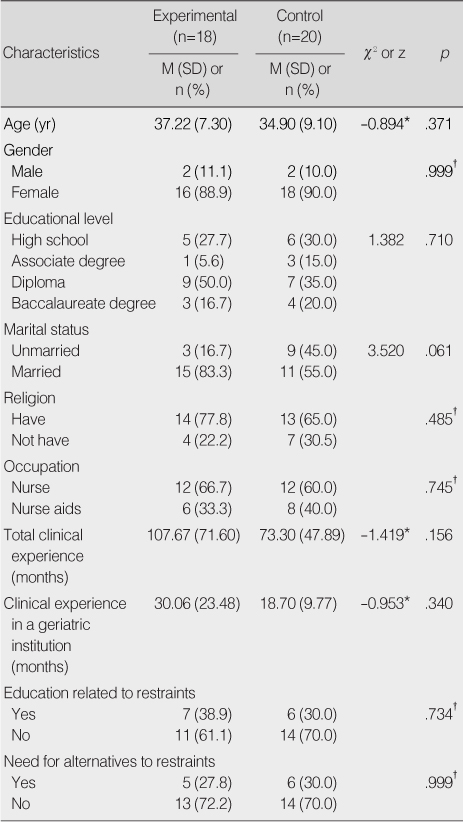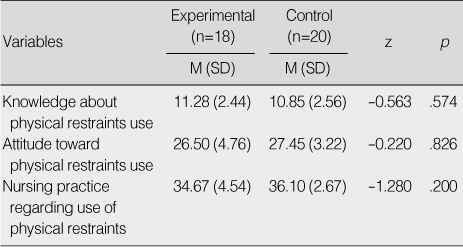Articles
- Page Path
- HOME > J Korean Acad Nurs > Volume 39(6); 2009 > Article
-
Original Article
- Effects of an Educational Program for the Reduction of Physical Restraint Use by Caregivers in Geriatric Hospitals
- Keumbong Choi, Jinsun Kim
-
Journal of Korean Academy of Nursing 2009;39(6):769-780.
DOI: https://doi.org/10.4040/jkan.2009.39.6.769
Published online: December 31, 2009
1Part-time Lecturer, Department of Nursing, Chosun University, Gwangju, Korea.
2Associate Professor, Department of Nursing, Chosun University, Gwangju, Korea.
- Address reprint requests to: Kim, Jin Sun. Department of Nursing, Chosun University, 375 Seoseok-dong, Dong-gu, Gwangju 501-759, Korea. Tel: 82-62-230-6327, Fax: 82-62-230-6329, jinsun@chosun.ac.kr
Copyright © 2009 Korean Society of Nursing Science
Abstract
-
Purpose
- The purposes of this study were to develop an educational program to reduce the use of physical restraints for caregivers in geriatric hospitals and to evaluate the effects of the program on cargivers' knowledge, attitude and nursing practice related to the use of physical restraints.
-
Methods
- A quasi experimental study with a non-equivalent control group pretest-posttest design was used. Participants were recruited from two geriatric hospitals. Eighteen caregivers were assigned to the experimental group and 20 to the control group. The data were collected prior to the intervention and at 6 weeks after the intervention through the use of self-administered questionnaires. Descriptive statistics, χ2 test, Fisher's exact probability test, and Mann-Whitney U test were used to analyze the data.
-
Results
- After the intervention, knowledge about physical restraints increased significantly in experimental group compared to the control group. However, there were no statistically significant differences between the groups for attitude and nursing practice involving physical restraints.
-
Conclusion
- Findings indicate that it is necessary to apply knowledge acquired through educational programs to nursing practice to reduce the use of physical restraints. User friendly guidelines for physical restraints, administrative support of institutions, and multidisciplinary approaches are required to achieve this goal.
- 1. Allen-Burge R, Stevens A, Burgio L. Effective behavioral interventions for decreasing dementia-related challenging behavior in nursing homes. International Journal of Geriatric Psychiatry. 1999;14:213–232.ArticlePubMed
- 2. Capezuti E. Minimizing the use of restrictive devices in dementia patients at risk for falling. Nursing Clinics of North America. 2004;39:625–647.ArticlePubMed
- 3. Cohen J. Statistical power analysis for behavioral science. 1988;2nd ed.New York, NY, Academic Press.
- 4. Doerflinger DM. The relationship acute care nurse administrators' knowledge and attitudes and restraint reduction. 2004;VA, USA, George Mason University. Unpublished doctoral dissertation.
- 5. Engberg J, Castle NG, McCaffrey D. Physical restraint initiation in nursing homes and subsequent health. The Gerontologist. 2008;48:442–452.ArticlePubMed
- 6. Feng Z, Hirdes JP, Smith TF, Finne-Soveri H, Chi I, Du Pasquier JN, et al. Use of physical restraints and antipsychotic medications in nursing homes: A cross-national study. International Journal of Geriatric Psychiatry. 2009;24:1110–1118.ArticlePubMedPMC
- 7. Guttman R, Altman RD, Karlan MS. Report of the Council of Scientific Affairs: Use of restraint for patients in nursing homes. Archives of Family Medicine. 1999;8:101–105.PubMed
- 8. Hamers JP, Huizing AR. Why do we use physical restraints in the elderly. Zeitschrift für Gerontologie und Geriatrie. 2005;38:19–25.ArticlePDF
- 9. Huizing AR, Hamers JP, Gulpers MJ, Berger MP. Short-term effects of educational intervention on physical restraint use: A cluster randomized trial. BMC Geriatrics. 2006;6(17):1–10.PubMedPMC
- 10. Janelli LM, Scherer YK, Kanski GW, Neary MA. What nursing staff members really know about physical restraints. Rehabilitation Nursing. 1991;16:345–348.ArticlePubMed
- 11. Janelli LM, Stamps D, Dells L. Physical restraints use: A nursing perspective. Journal of the Academy of Medical-Surgical Nurses. 2006;15:163–167.
- 12. Kang SH. A study on nurses' knowledge and attitude toward the use of physical restraints. 2003;Gwangju, Chonnam National University. Unpublished master's thesis.
- 13. Kim JS, Oh HY. Perceptions and attitude on use of physical restraints among caregivers in long term care facilities. Journal of the Korean Gerontological Society. 2006;26:347–360.
- 14. Kim KS, Chi SA. A study on perceptions about physical restraint use of nurses' and doctors' in hospital setting. The Chung-Ang Journal of Nursing. 2001;5:65–78.
- 15. Kim KS, Kim JH, Lee SH, Cha HK, Shin SJ, Chi SA. The physical restraint use in hospital nursing situation. Journal of Korean Academy of Nursing. 2000;30:60–71.ArticlePDF
- 16. Korea National Statistical Office. 2008 Statistics for the elderly. 2008;10 01 Retrieved November 5, 2008. from http://www.kosis.kr.
- 17. Lee KJ, Kweoun MS. Perceptions of nurses, nurse assistants, and families on the use of physical restraint with elderly people in care facilities. Journal of Korean Gerontological Nursing. 2001;3:158–168.
- 18. Lewin K. Field theory in social science. 1951;New York, NY, Harper & Row.
- 19. Ludwick R, Meehan A, Zeller R, O'toole R. Safety work: Initiating, maintaining, and terminating restraints. Clinical Nurse Specialist. 2008;22(2):81–87.PubMed
- 20. Mamun K, Lim J. Use of physical restraints in nursing homes: Current practice in Singapore. Annals of Academy of Medicine, Singapore. 2005;34:158–162.Article
- 21. Ministry for Health, Welfare and Family Affairs. Human rights protection and safety management guideline for senior citizens welfare institution. 2006;05 23 Retrieved June 11, 2007. from http://www.mw.go.krhttp://www.mw.go.kr.
- 22. Nay R, Koch S. Overcoming restraint use: Examining barriers in Australian aged care facilities. Journal of Gerontological Nursing. 2006;32:33–38.ArticlePubMed
- 23. Oh JJ. The experience of nursing staff on the dementia patients' aggressive behavior. Journal of Korean Academy of Nursing. 2000;30:293–306.ArticlePDF
- 24. Park M, Tang JH. Evidence-based guideline: Changing the practice of physical restraint use in acute care. Journal of Gerontological Nursing. 2007;33(2):9–16.ArticlePubMed
- 25. Pekkarinen L, Elovainio M, Sinervo T, Finne-Soveri H, Noro A. Nursing working conditions in relation to restraint practices in long-term care units. Medical Care. 2006;44:1114–1120.ArticlePubMed
- 26. Scherer YK, Janelli LM, Kanski GW, Neary A, Morth NE. The nursing dilemma of restraints. Journal of Gerontological Nursing. 1991;17(2):14–17.Article
- 27. Slettebo A, Bunch EH. Solving ethically difficult care situations in nursing homes. Nursing Ethics. 2004;11:543–552.ArticlePubMedPDF
- 28. Smith NH, Timms J, Parker VG, Reimels EM, Hamlin A. The impact of education on the use of physical restraints in the acute care setting. Journal of Continuing Education in Nursing. 2003;34:26–33.ArticlePubMed
- 29. Strumpf NE, Robinson J, Wagner J, Evans L. Restraint free care: Individualized approaches for frail elders. 1998;New York, NY, Springer Publishing Company.
- 30. Suen LK, Lai CK, Wong TK, Chow SK, Kong SK, Ho JY, et al. Use of physical restraints in rehabilitation settings: Staff knowledge, attitudes and predictors. Journal of Advanced Nursing. 2006;55:20–28.ArticlePubMed
- 31. Testad I, Aasland AM, Aarsland D. The effect of staff training on the use of restraint in dementia: A single-blind randomized controlled trial. International Journal of Geriatric Psychiatry. 2005;20:587–590.PubMed
- 32. Wang WW. Physical restraint use on people with dementia: A review of the literature. Australian Journal of Advanced Nursing. 2005;22(4):46–52.
- 33. Yeo JM, Park MH. Effect of an education program for nurses on the use of restraints. Journal of Korean Academy of Nursing. 2006;36:532–541.PubMed
REFERENCES
Figure & Data
REFERENCES
Citations

- Patterns of Physical Restraints and Their Associated Factors Among Personal Care Assistants Working at Daycare Centers in Korea
Song-Iee Hong, Haenim Lee, So Youn Chung
Journal of Gerontological Social Work.2025; : 1. CrossRef - Development of SMILE-MOM: a metaverse-based support program for single mothers
Minyoung Woo, Sun-Mi Chae
BMC Pregnancy and Childbirth.2025;[Epub] CrossRef - Information-Motivation-Behavioral Skill model-based physical restraint education program for nursing care providers in long-term care hospitals: A quasi-experimental repeated measures non-equivalent control group design
Sukhyun Jun, Haejung Lee
Journal of Korean Gerontological Nursing.2024; 26(3): 288. CrossRef - Factors affecting nursing practice of patient physical restraint among nurses
Jihyun Kim, Yaki Yang
Archives of Public Health.2024;[Epub] CrossRef - Interventions for preventing and reducing the use of physical restraints for older people in all long-term care settings
Ralph Möhler, Tanja Richter, Sascha Köpke, Gabriele Meyer
Cochrane Database of Systematic Reviews.2023;[Epub] CrossRef - Factors Influencing Nursing Practice for Physical Restraints among Nurses in the Intensive Care Unit
Da Eun Kim, Hye Sook Min
Journal of Korean Critical Care Nursing.2022; 15(3): 62. CrossRef - Effect of Interventional Educational Programs on Intensive Care Nurses' Perception, Knowledge, Attitude, and Practice About Physical Restraints
Mohamad Ahmadi, Mohammad Iraj Bagheri-Saweh, Bijan Nouri, Omid Mohamadamini, Sina Valiee
Critical Care Nursing Quarterly.2019; 42(1): 106. CrossRef - Improving ICU Nurses’ Practices of Physical Restraints in Jordan: Effect of an Educational Program
Heba Nasrate, Aseel Shamlawi, Muhammad W. Darawad
Health.2017; 09(12): 1632. CrossRef - The Effect of Elderly Nursing Care Education Programs on Nurses' Knowledge, Attitudes and Nursing Performance Toward the Elderly
Keum Bong Choi
The Journal of Korean Academic Society of Nursing Education.2012; 18(3): 522. CrossRef - Development and Effects of an e-Learning Program in Operating Room Nursing for Nursing Students
Eun Hee Park, Seon Young Hwang
Journal of Korean Academy of Nursing.2011; 41(1): 36. CrossRef - Interventions for preventing and reducing the use of physical restraints in long-term geriatric care
Ralph Möhler, Tanja Richter, Sascha Köpke, Gabriele Meyer
Cochrane Database of Systematic Reviews.2011;[Epub] CrossRef
Educational Program
Homogeneity Test for Characteristics between Experimental and Control Group (N=38)
*Mann-Whitney U test; †Fisher's exact probability test.
Homogeneity Test of Outcome Variables between Experimental and Control Group (N=38)
Group Comparison of Mean Differences of Knowledge, Attitude, and Nursing Practice on Physical Restraints Use (N=38)
Exp.=experimental group; Cont.=control group.
*Mann-Whitney U test; †Fisher's exact probability test.
Exp.=experimental group; Cont.=control group.
 KSNS
KSNS
 E-SUBMISSION
E-SUBMISSION




 Cite
Cite

